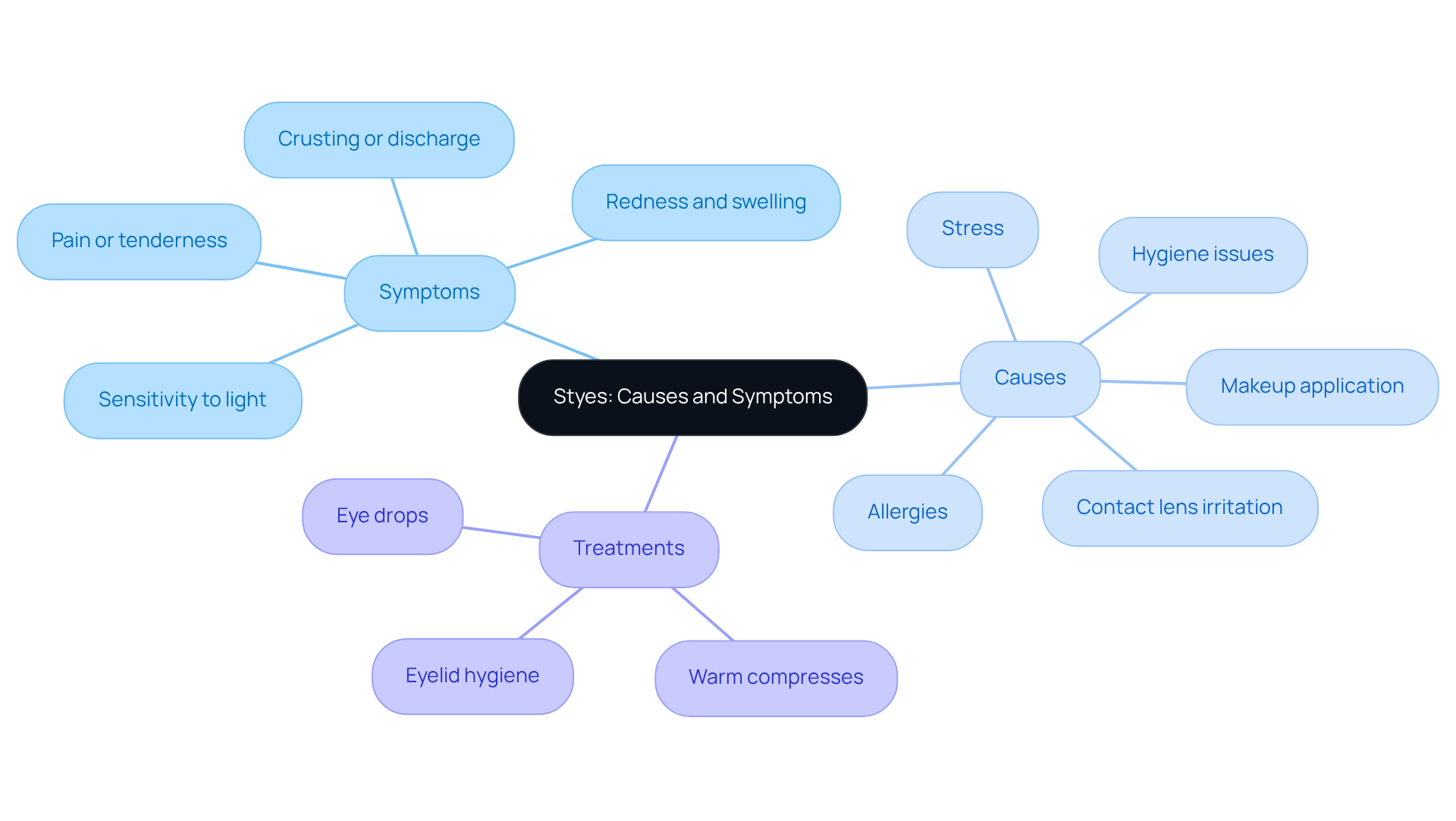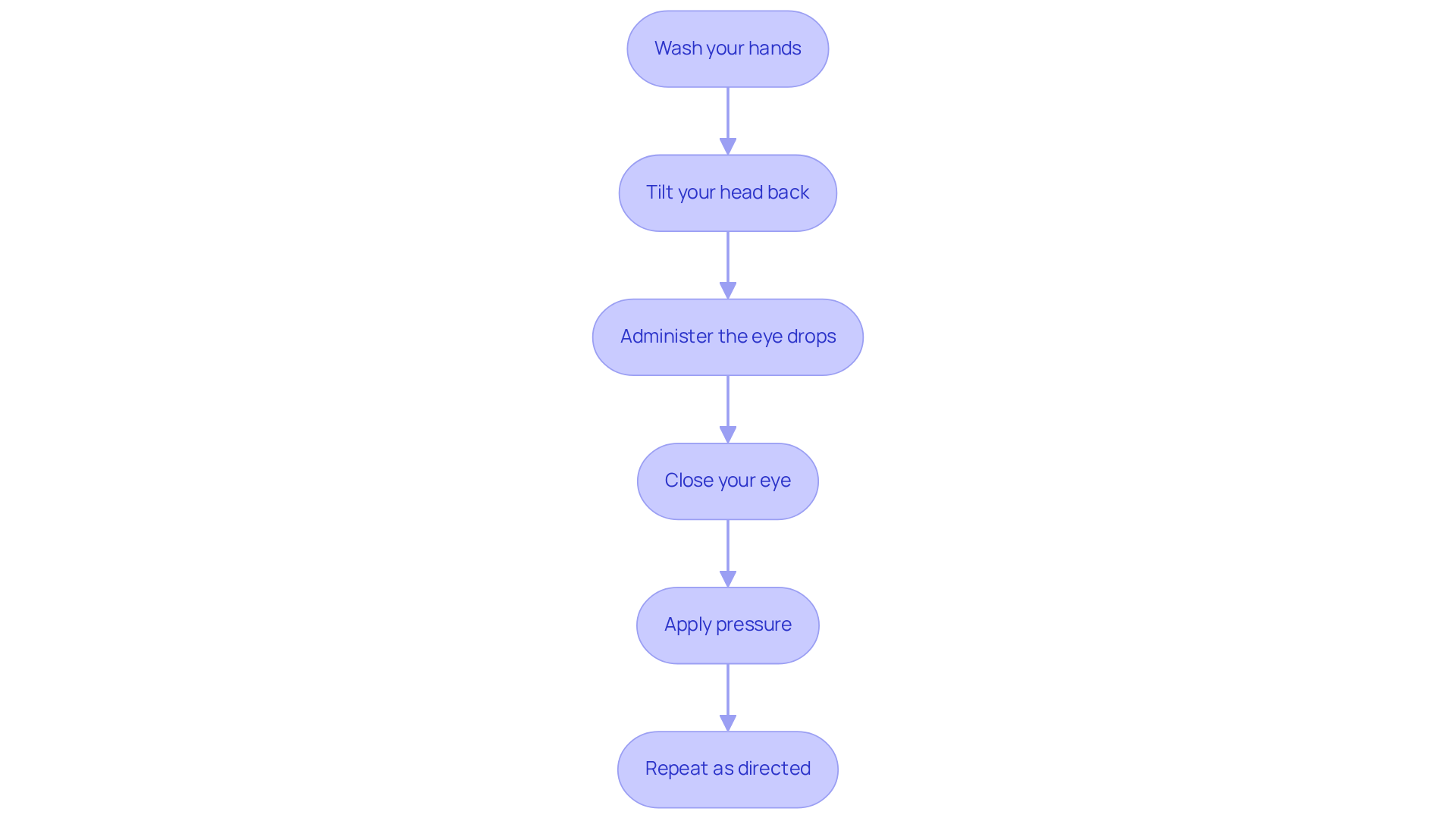Posted by: Northwest Eye in General on July 16, 2025
Overview
We understand that dealing with styes can be uncomfortable and concerning. This article provides essential tips for effectively using eye drops to relieve styes, emphasizing the importance of hand hygiene and proper administration techniques. It’s common to feel unsure about the process, but adhering to medical guidance can make a significant difference.
Evidence shows that following these steps can enhance treatment efficacy and boost your confidence in self-administering eye drops. We are here to help you through this process, ultimately promoting faster healing of styes. Remember, taking care of yourself is a crucial step towards recovery.
Introduction
Understanding the nuances of eye health is crucial, especially when it comes to common conditions like styes, which can cause discomfort and concern. We understand that approximately one in five individuals experience eye infections at some point, highlighting the importance of effective treatment methods, such as eye drops.
However, it’s common to feel unsure about the proper application techniques, leading to wasted medication and prolonged discomfort.
How can you ensure you are using eye drops correctly for optimal stye relief while also adopting preventive measures to enhance your eye hygiene? We are here to help you through this process.
Understand Styes: Causes and Symptoms
A hordeolum, often known as a chalazion, can manifest as a painful red bump on your eyelid, typically located near the edge of your eyelashes. This condition arises from an infection in the oil glands of the eyelid, leading to inflammation and swelling. We understand that recognizing the symptoms can be concerning, so here are some key signs to look out for:
- Redness and swelling: The affected area may appear noticeably red and swollen.
- Pain or tenderness: You might experience discomfort or a sensation of pressure in the area.
- Sensitivity to light: Bright lights could cause discomfort.
- Crusting or discharge: In some instances, the bump may ooze pus or other fluids.
Promptly identifying these symptoms is crucial for effective management. Many individuals find relief through home remedies or over-the-counter treatments, including eye drops for stye. Recent studies indicate that eye infections are common, affecting about 1 in 5 people at some point in their lives, with varying frequency across age groups. For instance, children may face eye infections more often due to hygiene issues, while adults often deal with risks from stress, makeup application, allergies, and contact lens irritation.
It’s reassuring to know that eyelid bumps are typically not contagious, alleviating concerns about spreading the condition. Styes tend to be more prevalent in adults than in children, as the oil in adult oil glands is thicker, making them more susceptible to blockage.
Additionally, conditions such as conjunctivitis, dry eye disease, and allergies can lead to similar symptoms of redness and irritation. Understanding the underlying causes of eye discomfort is essential. Real-world examples show that treatments like warm compresses and maintaining eyelid hygiene can significantly ease symptoms. Specialists emphasize that early intervention and appropriate treatment, including eye drops for stye, can lead to a quick resolution of eye bumps, usually within one to two weeks. We recommend avoiding makeup or contact lenses until your eye condition has healed and refraining from squeezing or popping the bump to prevent worsening the infection.
By understanding these symptoms and their implications, you empower yourself to seek timely medical advice, ensuring optimal eye health. If an eye infection persists or worsens, it’s important to consult a healthcare provider for proper management. Furthermore, regular eye exams are crucial, especially for children, to monitor and address any potential eye issues early on. We are here to help you through this process and ensure your eye health is prioritized.

Apply Eye Drops Effectively for Stye Relief
To effectively use eye drops for stye relief, we understand that following these essential steps can make a difference in your experience:
- Wash your hands: Begin by thoroughly washing your hands with soap and water to prevent introducing bacteria into your eye. It’s important to note that studies show only 3% of patients washed their hands before administration, underscoring the significance of this step.
- Tilt your head back: Look up at the ceiling to create a pocket in your lower eye area, which will help in placing the drops more easily.
- Administer the eye drops for stye: Hold the dropper above your eye and gently squeeze to release the prescribed number of eye drops into the fold of your lower eye. Remember, ensuring the dropper tip does not touch your eye or eyelid is crucial to avoid contamination. Expert Sandra R. Montezuma points out that touching the dropper can lead to improper technique and decreased patient satisfaction.
- Close your eye: After applying the drops, gently close your eye and avoid excessive blinking. This allows the medication to spread evenly across the surface of your eye.
- Apply pressure: If advised by your ophthalmologist, apply gentle pressure to the inner corner of your eye for about a minute to enhance absorption of the medication. This technique can significantly improve the effectiveness of your treatment.
- Repeat as directed: Be sure to adhere to your healthcare provider’s instructions regarding how often to apply the drops.
By following these steps, you can ensure effective delivery of the eye drops for stye, which promotes faster healing and improved outcomes. In fact, 91% of patients reported feeling more confident in their ability to self-administer eye drops after receiving education on proper techniques. It’s common to feel unsure, but avoiding common pitfalls—like failing to close the eye after instillation—can prevent medication waste and enhance efficacy. By implementing these best practices, you are taking a proactive step towards enhancing your treatment experience and achieving better results. We are here to .

Maintain Eye Hygiene to Prevent Styes
To prevent styes, it is essential to maintain good eye hygiene. We understand that taking care of your eyes can feel overwhelming, but following these best practices can make a significant difference:
- Wash your hands regularly: Always wash your hands before touching your face or eyes, especially when inserting or removing contact lenses. This simple step can significantly reduce the risk of transferring bacteria.
- Avoid touching your eyes: It’s common to feel the urge to rub or touch your eyes, but refraining from this can minimize the risk of transferring bacteria. This is particularly crucial for individuals susceptible to eye infections.
- Clean your eyelids: Using a gentle eye scrub or warm compress daily can help keep your eyes clean. Regular cleaning removes debris and bacteria that can lead to stye formation, which can be treated with eye drops for stye. Studies indicate that only 33.2% of respondents reported consciously washing their eyelids, highlighting a significant gap in awareness.
- Remove cosmetics before bed: Always ensure that eye cosmetics are removed before sleeping. Leaving cosmetics on can block oil glands and heighten the risk of eyelid bumps. Dr. Winnie Tseng highlights, “Proper eyelid cleanliness is crucial for avoiding eye infections, including taking off cosmetic products each night.”
- Replace old cosmetics: Discarding old beauty products, especially eye cosmetics, is essential to prevent bacterial growth. Using fresh products is vital for maintaining eye health, as not removing makeup at the end of the day is a frequent reason for eye infections.
- Care for contact lenses: Following proper hygiene practices when handling contact lenses, including cleaning and storing them correctly, assists in avoiding infections that may result in eye irritations.
Adopting these cleanliness routines can greatly lower the chances of developing eye infections and enhance overall eye wellness. Real-world instances demonstrate that regular eyelash hygiene can reduce the frequency of infections, highlighting the significance of education and awareness in eye care. Additionally, be mindful of common pitfalls, such as using old cosmetics or neglecting to clean eyelids, as these can increase the risk of styes, which may necessitate the use of eye drops for stye. We are here to help you through this process.

Conclusion
Recognizing the importance of proper eye care is essential for managing and preventing styes effectively. We understand that dealing with eye discomfort can be concerning, and this article highlights the significance of understanding styes, their causes, symptoms, and the role of eye drops in providing relief. By following best practices for applying eye drops and maintaining eye hygiene, you can take proactive measures to enhance your eye health and mitigate discomfort.
Key insights include:
- The necessity of washing your hands before applying eye drops
- The correct technique for administering the drops
- The importance of adhering to hygiene practices to prevent stye formation
It’s common to feel uncertain about when to seek medical attention, but understanding the symptoms can lead to quicker resolutions and improved outcomes. By implementing these strategies, you can feel empowered in your approach to eye health.
Ultimately, prioritizing eye hygiene and employing effective treatment methods not only alleviates current discomfort but also serves as a vital step in preventing future occurrences. Taking action today by adopting these practices can lead to healthier eyes and a more comfortable life. Remember, we are here to help you through this process.
Frequently Asked Questions
What is a hordeolum and what are its common symptoms?
A hordeolum, also known as a chalazion, is a painful red bump on the eyelid that typically appears near the edge of the eyelashes. Common symptoms include redness and swelling, pain or tenderness, sensitivity to light, and possible crusting or discharge.
What causes a hordeolum?
A hordeolum arises from an infection in the oil glands of the eyelid, leading to inflammation and swelling.
How common are eye infections like styes?
Eye infections, including styes, are common and affect about 1 in 5 people at some point in their lives, with varying frequency across different age groups.
Who is more likely to experience styes, children or adults?
Styes tend to be more prevalent in adults than in children, as adults have thicker oil in their oil glands, making them more susceptible to blockage.
Are styes contagious?
No, eyelid bumps like styes are typically not contagious, so there is no concern about spreading the condition.
What are some underlying conditions that can cause similar symptoms to a hordeolum?
Conditions such as conjunctivitis, dry eye disease, and allergies can lead to similar symptoms of redness and irritation.
What are some effective treatments for styes?
Treatments that can provide relief include warm compresses, maintaining eyelid hygiene, and using over-the-counter eye drops for styes.
How long does it usually take for a hordeolum to resolve with appropriate treatment?
With appropriate treatment, a hordeolum typically resolves within one to two weeks.
What precautions should be taken while dealing with a hordeolum?
It is recommended to avoid makeup or contact lenses until the eye condition has healed and to refrain from squeezing or popping the bump to prevent worsening the infection.
When should someone seek medical advice for a hordeolum?
If an eye infection persists or worsens, it is important to consult a healthcare provider for proper management. Regular eye exams are also crucial, especially for children, to monitor and address any potential eye issues early on.






